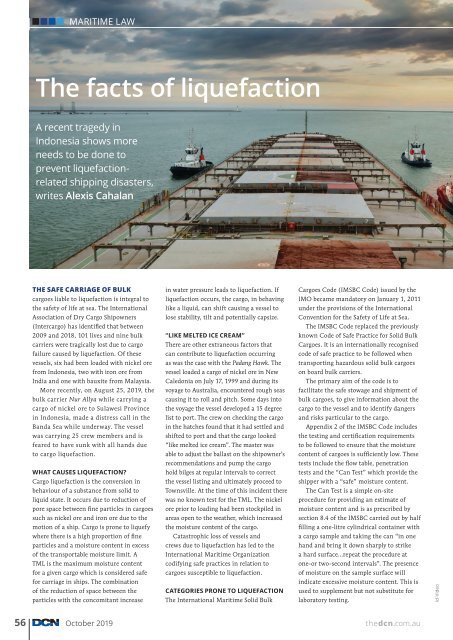DCN October Edition 2019
You also want an ePaper? Increase the reach of your titles
YUMPU automatically turns print PDFs into web optimized ePapers that Google loves.
MARITIME LAW<br />
The facts of liquefaction<br />
A recent tragedy in<br />
Indonesia shows more<br />
needs to be done to<br />
prevent liquefactionrelated<br />
shipping disasters,<br />
writes Alexis Cahalan<br />
THE SAFE CARRIAGE OF BULK<br />
in water pressure leads to liquefaction. If<br />
Cargoes Code (IMSBC Code) issued by the<br />
cargoes liable to liquefaction is integral to<br />
liquefaction occurs, the cargo, in behaving<br />
IMO became mandatory on January 1, 2011<br />
the safety of life at sea. The International<br />
like a liquid, can shift causing a vessel to<br />
under the provisions of the International<br />
Association of Dry Cargo Shipowners<br />
lose stability, tilt and potentially capsize.<br />
Convention for the Safety of Life at Sea.<br />
(Intercargo) has identified that between<br />
The IMSBC Code replaced the previously<br />
2009 and 2018, 101 lives and nine bulk<br />
“LIKE MELTED ICE CREAM”<br />
known Code of Safe Practice for Solid Bulk<br />
carriers were tragically lost due to cargo<br />
There are other extraneous factors that<br />
Cargoes. It is an internationally recognised<br />
failure caused by liquefaction. Of these<br />
can contribute to liquefaction occurring<br />
code of safe practice to be followed when<br />
vessels, six had been loaded with nickel ore<br />
as was the case with the Padang Hawk. The<br />
transporting hazardous solid bulk cargoes<br />
from Indonesia, two with iron ore from<br />
vessel loaded a cargo of nickel ore in New<br />
on board bulk carriers.<br />
India and one with bauxite from Malaysia.<br />
Caledonia on July 17, 1999 and during its<br />
The primary aim of the code is to<br />
More recently, on August 25, <strong>2019</strong>, the<br />
voyage to Australia, encountered rough seas<br />
facilitate the safe stowage and shipment of<br />
bulk carrier Nur Allya while carrying a<br />
causing it to roll and pitch. Some days into<br />
bulk cargoes, to give information about the<br />
cargo of nickel ore to Sulawesi Province<br />
the voyage the vessel developed a 15 degree<br />
cargo to the vessel and to identify dangers<br />
in Indonesia, made a distress call in the<br />
list to port. The crew on checking the cargo<br />
and risks particular to the cargo.<br />
Banda Sea while underway. The vessel<br />
in the hatches found that it had settled and<br />
Appendix 2 of the IMSBC Code includes<br />
was carrying 25 crew members and is<br />
shifted to port and that the cargo looked<br />
the testing and certification requirements<br />
feared to have sunk with all hands due<br />
“like melted ice cream”. The master was<br />
to be followed to ensure that the moisture<br />
to cargo liquefaction.<br />
able to adjust the ballast on the shipowner’s<br />
content of cargoes is sufficiently low. These<br />
recommendations and pump the cargo<br />
tests include the flow table, penetration<br />
WHAT CAUSES LIQUEFACTION?<br />
hold bilges at regular intervals to correct<br />
tests and the “Can Test” which provide the<br />
Cargo liquefaction is the conversion in<br />
the vessel listing and ultimately proceed to<br />
shipper with a “safe” moisture content.<br />
behaviour of a substance from solid to<br />
Townsville. At the time of this incident there<br />
The Can Test is a simple on-site<br />
liquid state. It occurs due to reduction of<br />
was no known test for the TML. The nickel<br />
procedure for providing an estimate of<br />
pore space between fine particles in cargoes<br />
ore prior to loading had been stockpiled in<br />
moisture content and is as prescribed by<br />
such as nickel ore and iron ore due to the<br />
areas open to the weather, which increased<br />
section 8.4 of the IMSBC carried out by half<br />
motion of a ship. Cargo is prone to liquefy<br />
the moisture content of the cargo.<br />
filling a one-litre cylindrical container with<br />
where there is a high proportion of fine<br />
Catastrophic loss of vessels and<br />
a cargo sample and taking the can “in one<br />
particles and a moisture content in excess<br />
crews due to liquefaction has led to the<br />
hand and bring it down sharply to strike<br />
of the transportable moisture limit. A<br />
International Maritime Organization<br />
a hard surface…repeat the procedure at<br />
TML is the maximum moisture content<br />
codifying safe practices in relation to<br />
one-or two-second intervals”. The presence<br />
for a given cargo which is considered safe<br />
cargoes susceptible to liquefaction.<br />
of moisture on the sample surface will<br />
for carriage in ships. The combination<br />
of the reduction of space between the<br />
particles with the concomitant increase<br />
CATEGORIES PRONE TO LIQUEFACTION<br />
The International Maritime Solid Bulk<br />
indicate excessive moisture content. This is<br />
used to supplement but not substitute for<br />
laboratory testing.<br />
Id-Video<br />
56 <strong>October</strong> <strong>2019</strong><br />
thedcn.com.au
















